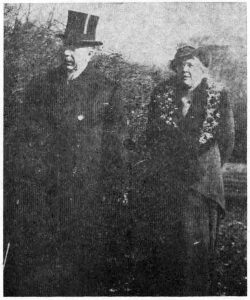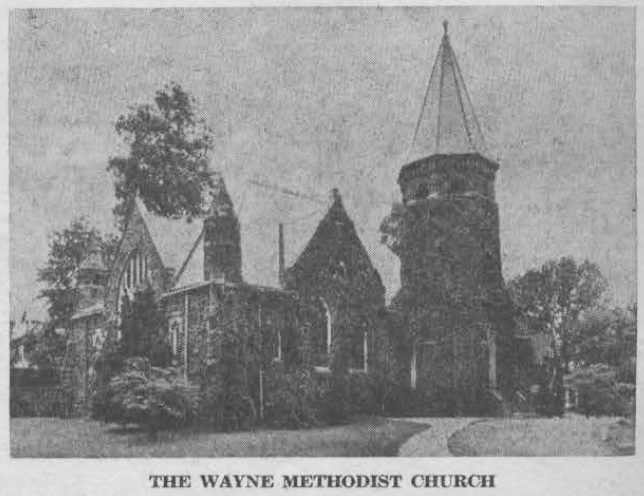Once the decision to build a church of their own, on the lot at the corner of Audubon and Runnymede avenues, had been made by the small group of Methodist families living in Wayne in the early 90’s, two committees became very active. One was the Finance Committee and the other was the Lot and Building Committee.
The first named had to set up a system for providing for the current expenses of Church services even at the early period when these services were still held in the school building. The last named had to make plans for the building of the church and the financing of that building.
The Finance Committee reported the adoption of the “Envelope System” as the “best plan under existing conditions for collecting the current revenue of the church.” And not only were all members of the church to be presented with these envelopes, but also “the children of the church and all others who may express a desire to use the same”, according to the old Minute Book. And the report of this first Finance Committee adds that, “the Pastor in as delicate and yet forceful a manner as possible shall, from time to time, call to the attention of the congregation that the church is supported entirely by the weekly offerings of the people made through the medium of the Collection Plates.”
But this matter of maintenance of services as carried on in the school was a minor one when compared to that of raising money for the erection of the new church building. The gift from the Wayne Estate of approximately an acre of land, valued at $3500, had indeed been a generous one. But when the bids from contractors were opened in the Philadelphia office of Thomas P. Lonsdale, the architect whose plans had been accepted, these bids were all rejected by the Lot and Building Committee. For they ranged from $20,715 to $21,516 for “the erection of church and sheds.”
However the Board of Trustees finally faced the fact that at least $21,000 would be required to finance the building and furnishing of the new church. Definite plans were completed after a loan of $10,000 had been obtained from the Philadelphia Savings Fund Society, and plans had been made for security pledges for the building fund from members of the church. Separate contracts for various portions of the work were awarded and Thomas Goreham, of Rosemont, was appointed superintendent of the building operations.
Ground for the new church edifice was broken on September 30, 1890, the cornerstone was laid on November 21, and the dedication services were held on July 28, 1891.
The now defunct Public Ledger of November 22, 1890, reported that “the exercises connected with the laying of the cornerstone of the Wayne M.E. Church, on the line of the Pennsylvania Railroad, attracted a large number of persons from Philadelphia, Berwyn, Bryn Mawr and other places.
“The occasion was also graced by the presence of the Rev. Thomas L. Bowman, of St. Louis, the Senior Bishop of the church, and the resident Bishop, Rev. Cyrus D. Foss, of Philadelphia.” In addition to various other Methodist Church dignitaries, others in attendance included the Rev. W.A. Patton, of the Wayne Presbyterian Church; the Rev. R.D. Naylor, of St. Luke’s Church of Bryn Mawr; the Rev. John W. Miller, of Radnor Baptist Church, and the Rev. C.W. Strom, of Berwyn. And this is to mention only a few of the many present for the occasion.
Introductory exercises were held in the Wayne Opera House, with the Ritual address made by the Rev. Dr. Hargis, presiding elder and the Ritual prayer by the Rev. Thomas A. Fernley. Bishop Bowman and Bishop Foss both made brief addresses, the latter saying, among other things, that “in the new church in the days to come, Christians will sing and pray, sermons will be preached, children will be baptised, happy brides will be married… and saints will be carried to their burial.”
From the Opera House, church members and their guests proceeded to the site of the church, where the cornerstone was laid by Bishop Foss. Among the articles deposited in the box were “a record of events leading up to the organization of the Sabbath School with its 49 members, and a list of the subscribers to the building fund.” Other records included “the report of the treasurer of the Board of Trustees covering all receipts and disbursements to date, and a copy of the resolutions adopted by the Board of Trustees upon receipt of the glad news that Mr. George W. Childs had generously donated the lot on which the church edifice is being erected.” Publications of various kinds included, “copies of the Christian Advocate, Philadelphia Methodist, Public Ledger, Wayne Times and Wayne News.” Also to be kept for posterity were “a copy of the order of the Corner Stone Laying; current coins of the United States, dated 1890; copy of the Bible; a copy of the Methodist Hymnal; a facsimile of the first issue of the Public Ledger; a photograph of George W. Childs and a copy of his “Recollections of General Grant.”
In the meantime while services were still being held in the school building, the first pastor, Edwin M. Pickop, had notified the Board of Trustees of the church that he wished to return to the Theological Seminary in Hartford, Conn. The Rev. Edward W. Burke, of Berrysburg, Dauphin County, was appointed to succeed him after “full consultation with the Bishop in charge of the Philadelphia Conference… Salary named to Brother Burke at the rate of $650 per annum and moving and travelling expenses paid, and $40 on account of salary would be advanced by the church.”
Brother Burke remained only from October, 1890, until January of the following year. Minutes of January 5, 1891, report for the Committee on Pastoral Relations that they “had determined a change in Pastorate necessary at the close of the Conference Year, and to that end had invited George H. Bickley, Jr., of Pottstown, to become pastor of the church with the beginning of the new Conference Year, the appointment to be subject to the approval of the Bishop.”
And so it was that the Rev. Bickley, the “earnest young pastor” was in the pulpit of the new Methodist Church when it was dedicated with much ceremony and before a large congregation of members, friends and visiting church dignitaries, on June 28, 1891.
(To be continued)
Note: Helen Sentman Harris (Mrs. Henry Harris) has telephoned your columnist from Media that her father’s name was Wesley G. Sentman, not Walter G. Sentman, as given in the first article of this series when the names were given of the four original Methodist families to come to Wayne in the late 80’s. While Mrs. Patterson regrets the innaccuracy, the mistake itself goes back to an error in the old Minute Book of the Wayne Methodist Church.



